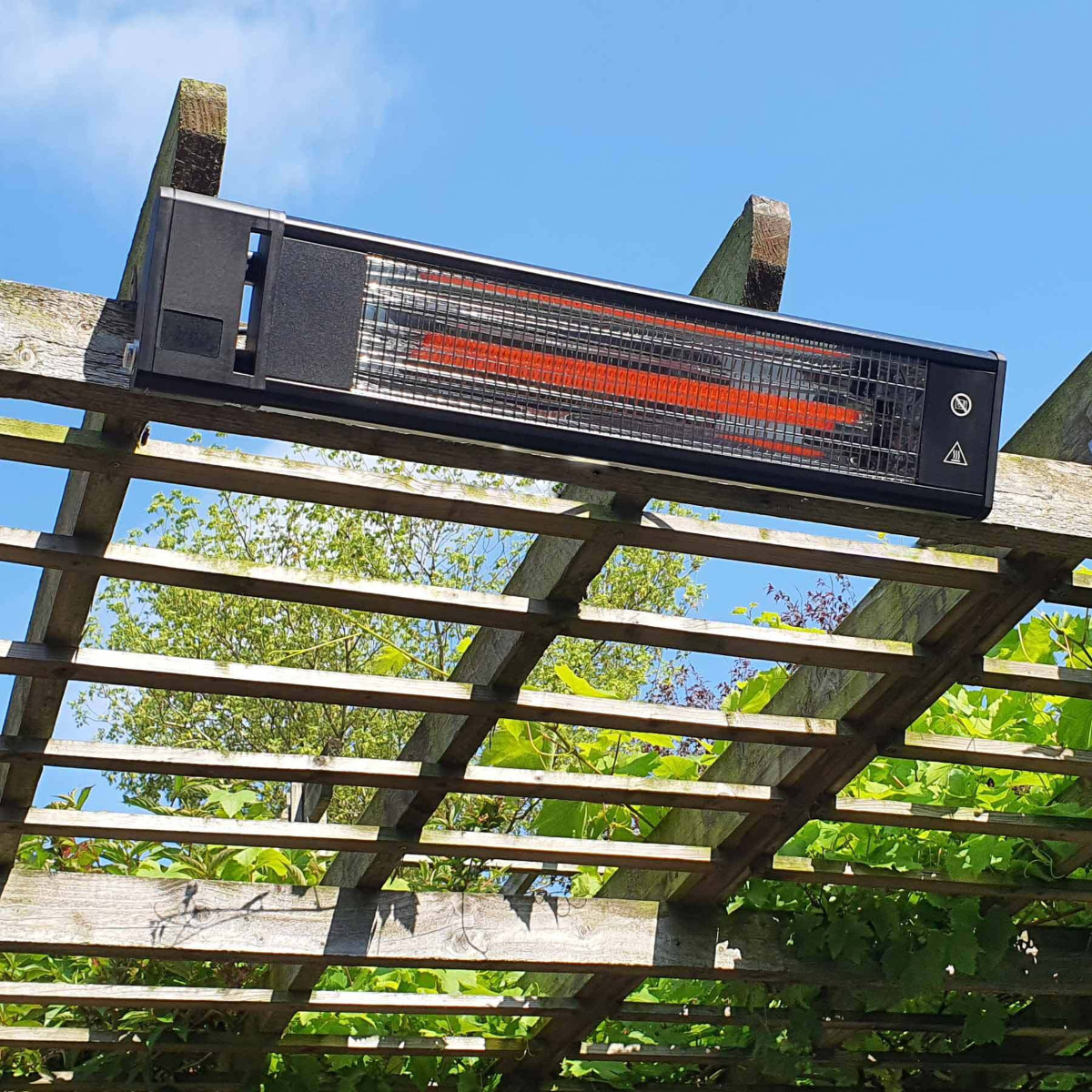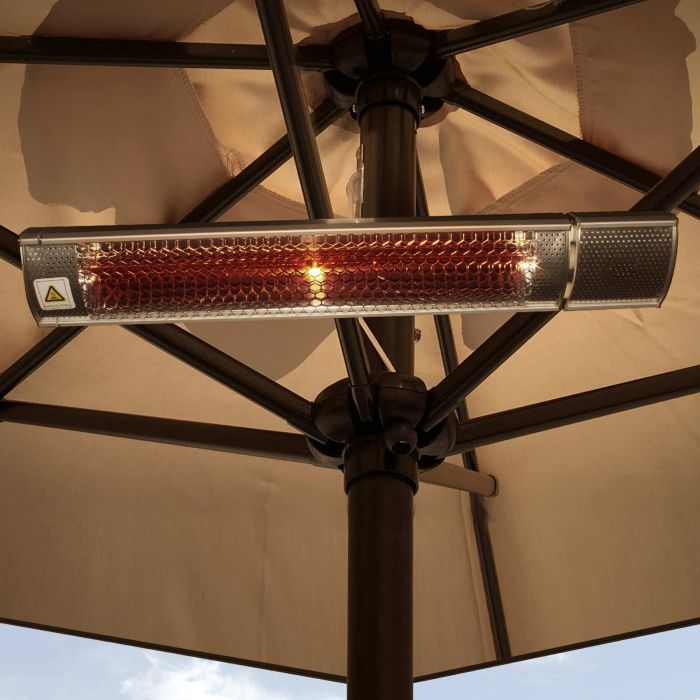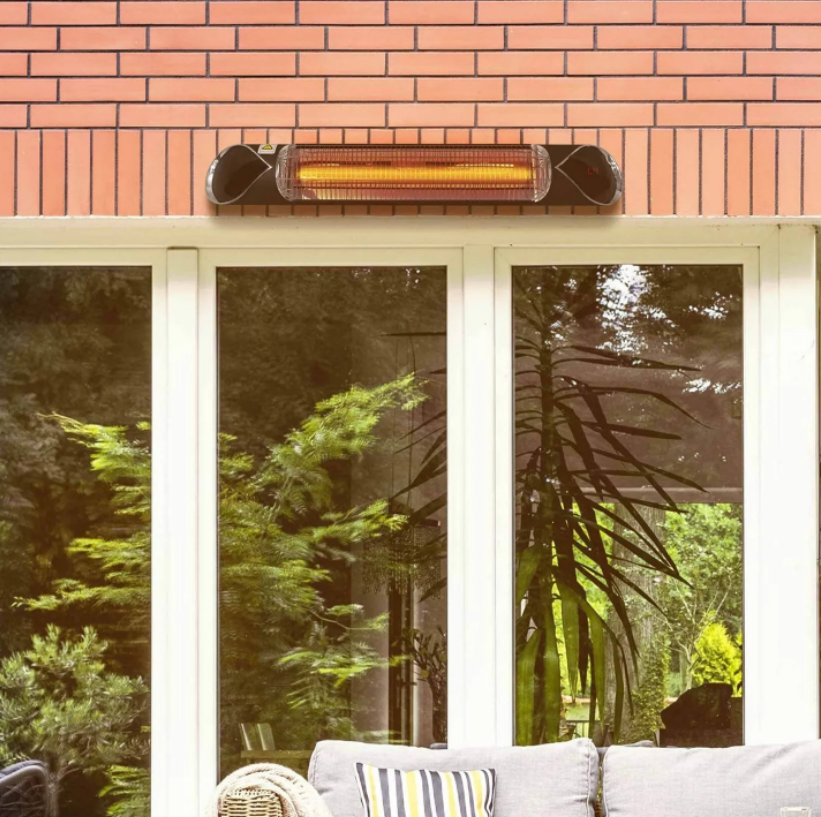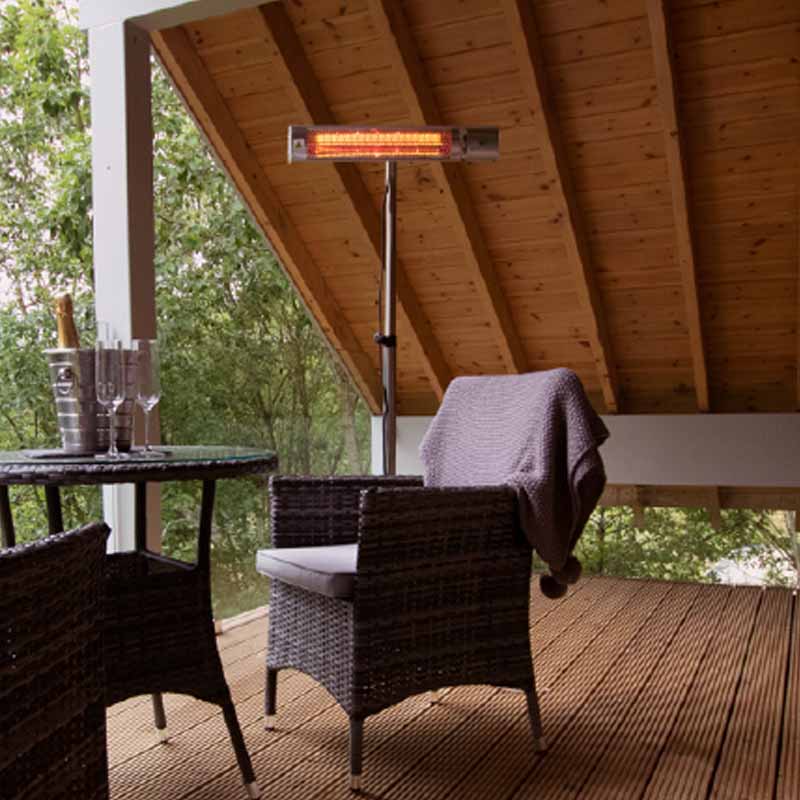

So many of us only use our gardens for a few months out of the year, but with the help of electric patio heaters, you can enjoy your outdoor space no matter the season. Electric patio heaters are efficient, cost-effective, and maintenance free. However, you might be wondering what’s involved in installing them. In short, we always recommend hardwiring your electric patio heaters. However, there are some cases where DIY-installation might be the better option. Let’s explore the reasons why and take a look at your choices if you’re looking to install one in your outdoor space.
Hardwiring electric patio heaters
So, why do we suggest hardwiring your electric patio heaters rather than installing them DIY? The answer is simple: hardwiring guarantees full protection against the elements. It means your patio heater will be able to withstand wind, rain, dust, dirt, and whatever else the outdoors might throw at it. Your electric patio heater comes waterproof as standard – check out our dedicated blog for more information – but hardwiring gives it that extra level of shielding, ensuring the best possible performance out of your heater and safe operation while using it.
How to hardwire an electric patio heater
This is a job for the professionals, so you’ll need to organise a callout from a qualified electrician. Hardwiring an electric patio heater involves wiring it into a fused spur – this is such a standard procedure that it shouldn’t take long or be particularly costly.
Why should you have your electric patio heater hardwired?
Other than the main reasons we’ve mentioned, there are plenty of other factors that come into play that make hardwiring preferable. After all, you might be looking to install your heater in a sheltered location, like a gazebo, and you’re not worried about wind or rain exposure.
Permanent fixture
Hardwiring your patio heater means it’s there to stay, so you don’t have to worry about setting it up whenever you want to spend time outdoors. Since electric patio heaters don’t require any maintenance, it can remain from its mounting location safely in between uses.
Ideal for regular, long-term use
If you use your garden regularly or have a commercial outdoor space that sees heavy footfall, a hardwired patio heater is designed to be left on for hours at a time; no micromanaging necessary.
Safe, peace-of-mind heating
All in all, hardwiring guarantees safety. So, if you’ve installed your heater on an exterior wall that is susceptible to catching the rain, or it’s in a warehouse setting that might be exposed to industrial-level cleaning, your hardwired patio heater will be protected from damage at any given time, ensuring a long-lasting product.
DIY-installing electric patio heaters
While we always recommend hardwiring your electric patio heater as a first resort, there are reasons why you might prefer to install it yourself. It’s all to do with how much you plan on using it. If you only see yourself turning your patio heater on once every few months when the weather or occasion calls for it, a quick DIY-fitting could come in handy. As it’s not a permanent fixture in your outdoor space, you’re not as limited when it comes to placement either. However, we always recommend some level of shelter.
How to DIY-install an electric patio heater
Getting your patio heater up and running requires only the most rudimentary DIY skills. Expect to find a UK fitted plug and cable with your purchase – simply mount your heater using the brackets and screws provided and plug it into an outdoor socket. Installation should take minutes and full instructions can be found in your heater’s manual. We’ve said it before, but we’ll say it again: DIY installation doesn’t safeguard your heater from the ingress of solids or moisture, so keep this in mind when choosing a mounting location.
Why should you DIY-install your electric patio heater?
There are quite a few reasons why DIY-fitting might be the preferable option. Perhaps you have a larger space or business that has hardwired patio heaters already, and you just need a little something extra to keep all your guests comfortable. Whatever the size or purpose of your outdoor space, here are a few main reasons to go the DIY route:
Quick & easy set-up
DIY-installation is free, simple, and doesn’t require any costly extras. All information is clearly outlined in the product manual and should take you a matter of minutes, so you’ll be able to get back to relaxing in no time.
Ideal for occasional use
If you know you’ll only be using your patio heater occasionally when the weather is good, DIY-fitting is a convenient option. Maybe you plan on taking it to a friend’s house or only like to get it out for your seasonal BBQ. Once you’re finished with it, you can store your patio heater safely in its original packaging ready for your next outdoor soirée.
Unrestricted placement
As your patio heater hasn’t been permanently fitted, you’re not limited to just one spot. So, if one day you’d like to set it up by your patio seating area and the next time in your garage workshop, it's more than possible to do that DIY.
Flexible mounting options for electric patio heaters
Now you have a better idea of whether your patio heater needs to be hardwired or is suitable for DIY-fitting. Let’s take a look at where exactly you can install it and which mounting option is the most suitable. If you’re unsure of what type of electric patio heater is best for your space, check out this blog.
Wall-mounting
Perhaps the most popular option, wall-mounted patio heaters offer direct warmth to those in its line of sight. With adjustable mounting brackets, you can control heat dispersion to your liking, ensuring optimal warmth throughout the day. As this spot is most likely a permanent fixture in your garden and is going to be less sheltered, like your house exterior or awning, hardwiring is the way to go.
Ceiling-mounting
Ideal for sheltered locales, ceiling-mounted heaters deliver a consistent spread of heat. It’s a totally discreet option that ensures each guest will feel the warmth, as well as adding that extra level of protection against the weather. Hardwiring your ceiling-mounted patio heater is ideal if you want to install it in a static location like a pergola or gazebo. However, if you’re looking to install your heater DIY, temporarily mounting it to your sun umbrella while you enjoy your evening hangout is a great idea.
Freestanding
If you’d rather not keep your heater in a permanent spot, freestanding fitting is your best bet. This is suited to larger spaces with multiple seating areas and is ideal if you want the freedom of feeling the warmth no matter where you are. This is only suitable for DIY-installation, and you’ll need to purchase the Ecostrad Infrared Patio Heater Stand which is compatible with many of our Ecostrad patio heaters. As it allows you to adjust the height to your preference, this is a truly versatile option for those spontaneous outdoor hangouts – weather permitting!
For absolutely everything you need to know before making a purchase, check out our buying guide.
Overhaul your outdoor space with electric patio heaters
Now you have everything you need to know about installing electric patio heaters, it’s time to start browsing. Our range is suitable for a variety of applications, whether you’re looking for a DIY-friendly portable heater, or something permanent for your draughty workshop. We have the best selection at the lowest prices, so browse our full collection and overhaul your space today.
Key learnings
- We always recommend professionally hardwiring your electric patio heaters because it guarantees full protection against the elements and ensures safe operation.
- Hardwiring is a permanent solution that is ideal for regular use and is suitable for installation in more exposed locations.
- DIY-installation is suitable if you plan on using your patio heater occasionally and in a sheltered location. DIY patio heaters can be made freestanding with a compatible stand, giving you greater freedom in terms of placement.









